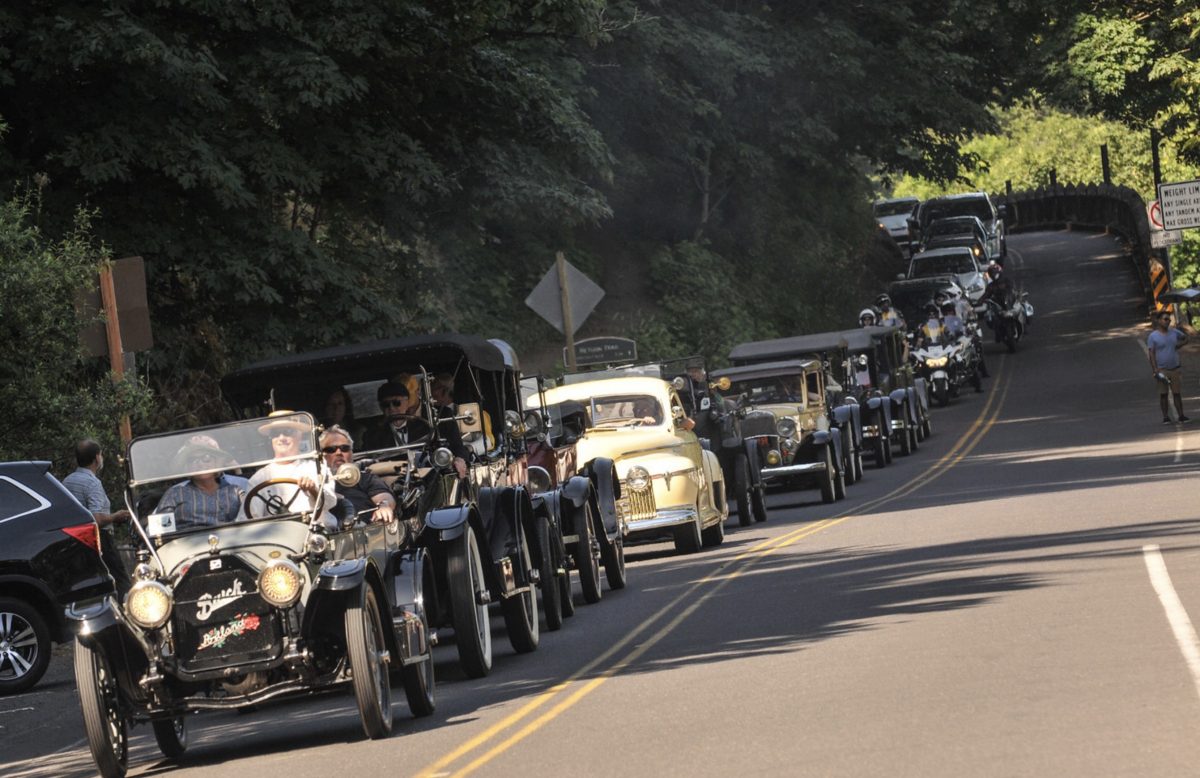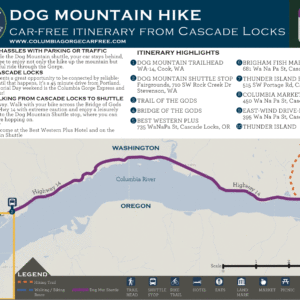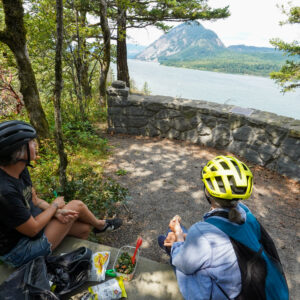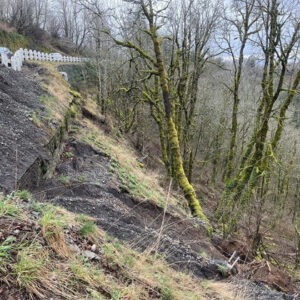
(Photo: J. Maus/BikePortland)
The head of the organization whose mission is to protect the Columbia River Gorge wants fewer people to drive cars through it.

(Photo: Friends of the Columbia Gorge)
Friends of the Columbia River Gorge Executive Director Kevin Gorman penned an article on the group’s website last month titled, How Much Love Is Too Much for the Gorge?.
“As we approach the summer season of mile-long backups on the Historic Columbia River Highway and full trailheads full by 9 a.m.,” Gorman writes, “more voices are asking what’s causing the congestion and what can we do about it?”
Gorman points to three main congestion culprits: a rise in tourism, booming regional population, and the inconvenient truth that around 99% of Gorge visitors arrive in an automobile.
What caught my eye were Gorman’s thoughts on a “holistic solution” to this nightmare. He says Oregon should look to Utah for inspiration, where authorities banned driving and introduced a shuttle bus service on the main scenic road in Zion National Park during the busy season. “Despite initial concerns, use of buses was a huge success,” Gorman shared. “Congestion on the road disappeared, bicycles started showing up, and the shuttle service provided local jobs.”
Advertisement

(Photo: J. Maus/BikePortland)
As we’ve reported, ODOT has already taken an in-depth look into similar measures for the Gorge. But so far, only a plan has been completed and nothing has been implemented. The state-run Columbia Gorge Express bus service has been a big success, but it’s not enough to lure people out of cars and make a real dent in congestion. At least not without a major boost in funding.
Gorman also plugged his group’s Gorge Towns to Trails project — a proposed 200-mile loop around the National Scenic Area that would create more recreational opportunities and could disperse visitors over a wider area. On a related note, ODOT continues to make exciting progress on the carfree sections of the Historic Columbia River Highway. The latest piece — a three-mile, $18 million segment from Wyeth to Lyndsay Creek — is slated for a ribbon-cutting August 3rd.
How does Gorman intend to pay for projects that will help rid the Gorge of its motorized menace? Charge people money to park their cars. He cites success of a program in Portland’s Washington Park that uses parking fees to pay for shuttles and other TDM strategies.
From the central city to our beloved Gorge, the negative impacts of too much driving know no boundaries. It’s time we set some. And it’s great to know that the coalition to do something about it is growing with people who “get it” like Mr. Gorman.
— Jonathan Maus: (503) 706-8804, @jonathan_maus on Twitter and jonathan@bikeportland.org
Never miss a story. Sign-up for the daily BP Headlines email.
BikePortland needs your support.






Thanks for reading.
BikePortland has served this community with independent community journalism since 2005. We rely on subscriptions from readers like you to survive. Your financial support is vital in keeping this valuable resource alive and well.
Please subscribe today to strengthen and expand our work.
The Earth and all of its inhabitants , except for motorists, will breath a sigh of relief when happy motoring is over. It seems that there is no place far enough or sturdy enough that it can’t be wrecked by humans in motorized vehicles.
Motorized vehicles brought you most of the items you us in your daily life.
“…no window that can’t be wrecked by people with hammers”
—“People with hammers built your house”
“…no forest meadow that can’t be wrecked by people walking all over it”
—“Everyone who ever did anything for you probably did some walking”
“…no building or bridge abutment that can’t be wrecked by people with spray paint”
—“People with paint painted everything you have that’s painted”
“…no natural area that can’t be wrecked by fire”
—“Fire heats your house”
Most things in the universe can be used to either help or harm. I think there’s a certain amount of tool/job appropriate use that is assumed in statements about motorized vehicles wrecking things.
Thank you for carrying water for the automotive complex. If you didn’t do it, I don’t know who would.
/s
Most of the food and items used by the middle and upper classes in the Pre-Civil war South were made by or paid for with the labor of slaves. That does not mean that Slavery can be defended because it benefited some folks. When the destruction of the biosphere is considered by future inhabitants of the earth they will look back on the legacy of the automobile no more charitably than we look back on slavery.
Wait… did you just use “ODOT”, “exciting progress” and “car-free” in the same sentence?
This past week i took two of my friends visiting from Mexico to Multnomah Falls and Hood River using the Gorge Express bus. The biggest issue are the stops and the quality of the buses. The buses are older and noiser and not the most pleasant to be in for the hour + bus ride and the stop in Hood River is literally in an empty field as well as the multnomah falls stop. Having the buses come more frequently is also necessary. I had a baby (and one of my friends is pregnant) and I was very worried about missing the last (6:15) bus out of Hood River.
My suggestion is to use some old shipping container and paint them in cool colors, add solar panels and lights. (it would be cool to rent bikes out of them or some other services) and place the stops in more convenient locations. Also just ride the bus all day and ask the drivers/passengers what it would take to get more people using it.
when did the Hood River stop change? I rode in March and the stop was right next to Full Sail. the regular bus was out of service so we had a big bus with room for more than the four bikes there were in the luggage compartment underneath. it was a hell of a deal for $7.
Perhaps remind bus travelers that travel by horse and stagecoach used to suck a LOT more.
Perspective.
Need to put in bike racks at all the trailheads.
I find it interesting that despite overwhelming demand to visit car-free places (the gorge, Mt. Hood, the Oregon Coast, Forest Park), people fail to internalize that a large part of what makes these places special is that they lack cars, and that we could have much of that same tranquility right here in town if we just created more car-free public space.
The Zion solution is exactly what we need. You would need park-and-ride lots in several spots, though. One just east of Troutdale, near Broughton Bluff, one at Multnomah Falls (re-allign the Interstate and build a garage on the south side), and one in Cascade Locks.
Outside of this, the only other solution I see is some sort of limited-access tolling system, based on demand. We have to get the cars off of the road. Only then will cycling and shuttles become a viable option.
Meanwhile close the Historic Highway beyond Crown Point Ainsworth to motorized vehicles, except local traffic with permits.
Anyone who travels to Zion is instantly converted to a bus advocate in national parks. The busses are a great place to meet people from all around the world and the rangers do a great job pointing out interesting sights along the way. The Zion busses work because they are both clean and frequent.
What happened to the Historic River Highway becoming one-way with a contraflow bikelane?
Bike Portland announced that was supposed to be implemented last Fall.
… anyone…????
As I recall that was a transitional option during the reopening process. But then a landslide happened and that option was not talked about anymore. It was never supposed to be a permanent traffic change.
Before the Zion solution was the Yosemite plan. Under President Carter, Yosemite put in place a plan to remove cars from the valley. Only those with camping reservations were to be allowed to drive in and only to their reserved spot. Everyone else (except those who hiked or cycled in) were to be brought in by shuttle buses that originated outside the park.
It’s nice to see some good old plans being dusted off and applied to new settings. Hopefully we can find ways to implement them this time ’round.
The Yosemite Valley is a sad example of car culture run amok. They’ve paved over huge swathes of meadow for parking lots. The traffic is horrible, and really destroys the atmosphere. I much prefer the Tioga Pass area.
ODOT has taken an in depth look.
Yes! Save the road way on the gorge for seniors and the disabled who need it.
They can ride the shuttle bus with everyone else.
What an ableist and out of touch statement! It’s possible to be anti-car and take the majority of cars off roads while still acknowledging that some folks with disabilities will always need accommodations. Also, until there is equity in TriMet/transit as a whole, then no, disabled folks cannot rely on busses the same way able bodied folks can. Simultaneity, y’all! Get with it
Hey, now— don’t accuse too quickly. I know Chris I’s statement was short, but that doesn’t necessarily mean it was “ableist” and “out of touch”. One might assume that specialty shuttle buses would include some accommodation for those that need it, and “rid[ing] the shuttle bus with everyone else” (rather than “like” everyone else) almost sounds inclusive rather than “ableist”.
“Also, until there is equity in TriMet/transit as a whole, then no, disabled folks cannot rely on busses the same way able bodied folks can.”
That’s kind of a leap. We’re not talking about Tri-Met “as a whole” here, just one specific shuttle bus, which again, as a special case, could very well include accommodations. Don’t assume Chris I was assuming that ALL other-abled folks could ALWAYS take THE bus everywhere—just one bus, to one place.
Now granted, there might be a few outliers for whom no standard accommodation used on any kind of shuttle bus might work. For those folks, sure, we might need to “accommodate” a few specially-permitted private vehicles.
I think Chris I’s statement was more hopeful than “out of touch”. Hope my assumption is right…
There are legitimately disabled people, and there are people who use minor disabilities (many of which are caused by lifestyle choices) to abuse the system and get special treatment. There was rampant abuse of the handicapped parking permit system in downtown Portland when it used to get people out of paying for parking. Carving out a loophole for a highly-valued limited access roadway like the proposed one here would lead to rampant abuse as well.
Disabled people use public transit every day. LIFT is a very expensive service that Trimet has to legally provide. A similar system could be used in the Gorge.
The Gorge would be a good place for a Cascade-ish regional passenger train. There is one per day on the Washington side–eastbound @5PM, westbound @9AM, as part of the Empire Builder line. I wonder how well a Portland-Dalles route would work. Many of us do NOT find driving a car in the gorge fun at all, just as the Cascade train’s success can’t be too unrelated to the un-fun of driving I-5.
The Pioneer is long gone, and there won’t be another passenger train to replace it for maybe fifty years, if we’re lucky? The Cascades run by Amtrak are a poor substitute for transit, Amtrak being a dysfunctional outfit from it’s inception doesn’t help matters.
Sitting trackside two weeks ago in Baker City and talking to the locals about the demise of the Pioneer only reinforced my thoughts that the car is winning the battle so far, unfortunately.
Don’t forget the other local train service that showed the promise of regional seasonal routes was the Lewis and Clark run that used three 1950s Budd self powered train cars between Portland and Astoria 15+ years ago. It was a great and intimate ride along the south bank of the Columbia River. All it needed was more frequency, longevity, PDX terminus AND bike racks. [ODoT Bring it back – updated – if you can.] I wonder if the three Budd cars are still laying around in a train yard rotting away, os got sold off?
http://www.brian894x4.com/LewisandClarkExplorer.html
The Lewis & Clark experiment sure was neat, and I blew it by not ever taking a trip. Many of my friends did but the timing was always off for me, being out of town etc.
Don’t know if it would have survived long term but damn it was great to have around. The RDC units might be up in Elgin now, they do have a few there for the tourist ops to Joseph.
Regarding the other poster about Cascades being successful, I guess we have to disagree on that. I want the service expanded greatly, the lack of stops is depressing for starters. Singletrack doesn’t really get in the way either, the whole run from SEA-VAN is single w/multiple sidings. A good bike ride is along Portal Way from Ferndale to the border to witness this in action. I totally agree about lack of ridership east on 84 ….
Some folks are still hopeful that the Pioneer line could one day re-open. I wouldn’t hold mine, my kids’, or even my grand-kids’ breath one this one personally, but who knows?
https://pioneertrain.org
Cascades works because most of the state’s population lives along the I-5 corridor, which is heavily congested for big portions of the day. None of that is true about I-84. I would love to see commuter rail along this corridor, but there just isn’t the demand to support it. The route also has a lot of single-track sections, which would make it hard to keep a frequent schedule.
Hey, I think it’s kind of fun to pass mile after mile of stationary cars waiting to get into M. Falls while I ride to Cascade Locks on my bike.
(Realistically, this is obviously not sustainable in any way shape or form . Something needs to be done. )
Sounds like a great idea for those busy tourists months.
Stick: charge $25 an hour for parking at the Gorge. Carrot: free electric shuttles on the half hour. Doing both at the same time “holistically” would wonders for altering behavior and improving the experience for everyone at the Gorge.
Does anyone know the history of the construction of the Multnomah Falls parking area? – I’m talking about the one in the middle of I-84 that you access via left entrances and exits, and then walk thru a tunnel under the highway to reach the lodge and the falls. I’m guessing this tourist accommodation was built as part of the design of I-84, but look at what it says to people in cars: “this is the easiest way to reach the best destination in the Gorge.” What if, instead of building a parking area for 100+ (?) cars, the designers had created just enough room for bus/coach parking and allowed tour operators to bid for that business? What a different situation we’d have today! My guess is that the designers in the car-happy 1950s and 60s thought no further than “People driving thru the Gorge on I-84 are gonna wanna stop anyway, so let’s build them a huge parking lot.” And the people did exactly that. Design is destiny.
I wish the generation that built I-84 had the foresight to put a bike path alongside it. Imagine a mostly-flat bike ride along the Columbia from the Sandy River to Multnomah Falls.
They did. It’s called the shoulder. People ride it often.
Maybe I should have specified “safe”, as in “not having cars race past at 70 mph a few feet away.”
You and I have different definitions of “often”, apparently.
I know ODOT has been trying to manage parking at Multnomah Falls. One possible approach: a bike path from Rooster Rock to Multnomah Falls. It looks to me like there’s room between the freeway and the railroad line for a bike path, although I don’t know how wide each right-of-way is. It would be a six mile long bike path, so that’s about a 30 minute ride for most people. That’s a nice family outing when there are no cars to contend with. If people could park at Rooster Rock and ride to the falls (I presume ODOT could offer plenty of bike racks), it would help reduce parking pressure at Multnomah Falls itself.
And that would also create a level bike trail that covers roughly 40% of the distance from Multnomah Falls to Troutdale — the beginning of a Gorge trail that doesn’t involve dodging cars on a narrow winding road with no shoulders, or an 876 foot elevation gain.
Eh, no. They can ride with everyone else.
Yay! Please post a a pic of your child riding there. Mmmmk?
I asked Google Maps for bike directions from Rooster Rock to Multnomah Falls. Google Maps drew a blank. Apparently, Google doesn’t think I-84 qualifies as a bike route.
I’d buy your child a cheeseburger if they can ride from vista house to Elowah falls.
And in the grand scheme of a large trip, what you mention in the waterfall area is a small piece of the pie. Also, I’d say that if someone is looking for a fun ride, St Helens and Adams are ripe for a good time with much less traffic than that of the gorge. FS 23/25 are both great roads to ride.
Part of our extended family (17 ppl ages 3-60 on one of our outings) just came back from Zion. The accesible shuttle system was great for us and the fact that it was free from town and “free” in the park made it quick and easy. I’m a huge fan of this for the Gorge!
My only complaint is that our immediate family would have taken our bikes if the rule about pulling over for the shuttles wasn’t in place (though I understand why it is).
Andrea, do you know if that’s a recent rule about pulling over on a bike to let the shuttle pass? Wasn’t in place when I was there 3 years ago; that, or I didn’t know about it.
Yes, Zion is a spectacular place to see on a bike. Hard to imagine it when it was open to motor vehicles, must have been a somewhat dreadful experience.
Also – I meant to ask – why is pulling over for a shuttle once every 10 minutes or so a dealbreakers?
I would gladly accept those terms if it means the roads are car-free. I wish I could make that deal every day.
Suppose you are an outsider who had planned a multi-day biking trip from Portland to Hood River, the Dalles and maybe a return by way of the south side of Mt Hood. Or maybe you could head north and take in Mt Adams and St Helens. You had heard of the great biking and scenery of this region, but maybe what really attracted you was the multi-million dollar bike paths that aim to connect Portland with Hood River. So suppose you head out to Troutdale on a weekend and start climbing up toward Crown Point. The first thing you will notice is the number of cars zooming up the old historic highway, perhaps the Porsche Club of Portland heading up to a picnic on Larch Mountain. “It’s ok,” you think, “the shoulder is wide even if they are speeding up the hill at 60 mph.” Once you get up to Crown Point, and weave your way around the cars, tour buses and RVs in the parking lot , like everyone else you are taken in by the scenery. You soak up the view and get ready for the descent into the waterfall zone. But lo and behold, there is nothing but cars blocking the way…, motor vehicles are lining up looking for parking at every waterfall and trail head all the way to Ainsworth State Park.
“Its ok,” you think, “next year I’m going to ride Europe.”
You forgot to mention the part about getting coal-rolled by a lifted pickup on the climb up to Corbett.
car haters will never stop – they got their start when they wanted cars banned so everyone would still have to ride horses – now they want cars banned so everyone will ride bikes – well, almost everyone still wants to get around by car – you people will always lose because for every one of you, there are a thousand of us